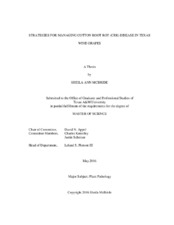| dc.description.abstract | Among the challenges facing the Texas winegrape industry is Phymatotrichopsis omnivora, the cotton root rot (CRR) pathogen. A survey instrument was created and distributed to grape growers which revealed that the disease is a serious problem in counties where acreage of new vineyards is on the increase. Grape growers expressed significant concern because there were no effective recommendations for disease control.
One control option for growers is the use of promising rootstock x scion combinations. In 2012, a root stock field trial was planted with two own-rooted grape varieties (Chardonnay, Merlot) and the same two varieties on Dog Ridge root stock. Both varieties on the root stock showed a significant statistical difference in disease development when compared to own-rooted vines. Merlot own-rooted vines were more resistant than the Chardonnay own-rooted vines.
Two experimental fungicide field trials were initiated in vineyards in the spring of 2012. In one vineyard, several fungicides were tested including flutriafol, a fungicide being used successfully to control CRR on cotton. In the commercial vineyard in Travis County, TX, flutriafol was applied at 0.26 lbs/a.i./acre (1X), 2.6 lbs/a.i./acre (10X), and 5.2 lbs/a.i./acre (20X) through a manually applied soil drench. There was a significantly lower level of disease development in the 10X plots, as compared to untreated controls. Vines treated with a 10X rate of flutriafol also showed decreased incidence of non-target foliar pathogens and possible plant health effects when compared to the other treatments.
In 2014, two new field trials were established using chemigation at an established vineyard and a newly planted vineyard. The experimental block at the newly planted vineyard consisted of 30 rows of Petite Syrah on 5BB rootstock containing 118 vines/row. Two rates of flutriafol at 0.26 lbs/a.i./acre (1X) and 0.52 lbs/a.i./acre (2X) were applied through the irrigation system with 10 plots (rows)/treatment. In the untreated plots, disease increased from 0-5.5% over a 12 week period following treatments. No disease was observed until week 11 in any of the treated plots. However, by week 12, disease incidence had increased to 2.5% and 1.4% in the 1X and 2X plots, respectively. Based on these and similar studies, a Section 24(c) special local needs registration was requested and granted for use by the grape growers to control Phymatotrichopsis omnivora. | en |


